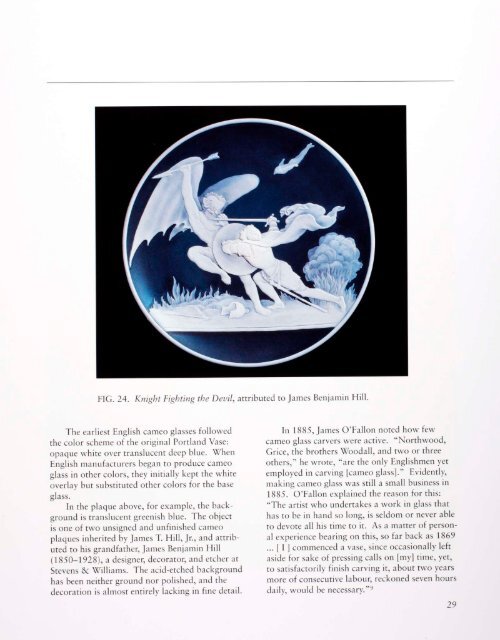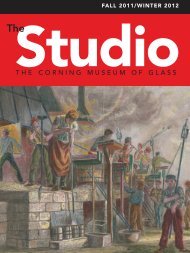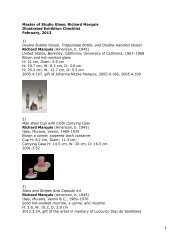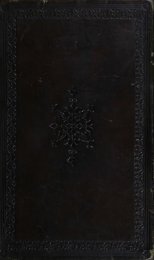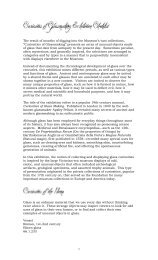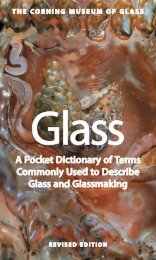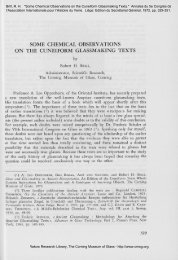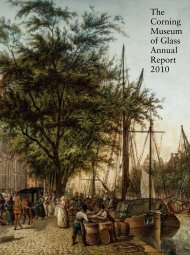english cameo glass in the corning museum of glass
english cameo glass in the corning museum of glass
english cameo glass in the corning museum of glass
You also want an ePaper? Increase the reach of your titles
YUMPU automatically turns print PDFs into web optimized ePapers that Google loves.
FIG. 24. Knight Fight<strong>in</strong>g <strong>the</strong> Devil, attributed to James Benjam<strong>in</strong> Hill.<br />
The earliest English <strong>cameo</strong> <strong>glass</strong>es followed<br />
<strong>the</strong> color scheme <strong>of</strong> <strong>the</strong> orig<strong>in</strong>al Portland Vase:<br />
opaque white over translucent deep blue. When<br />
English manufacturers began to produce <strong>cameo</strong><br />
<strong>glass</strong> <strong>in</strong> o<strong>the</strong>r colors, <strong>the</strong>y <strong>in</strong>itially kept <strong>the</strong> white<br />
overlay but substituted o<strong>the</strong>r colors for <strong>the</strong> base<br />
<strong>glass</strong>.<br />
In <strong>the</strong> plaque above, for example, <strong>the</strong> background<br />
is translucent greenish blue. The object<br />
is one <strong>of</strong> two unsigned and unf<strong>in</strong>ished <strong>cameo</strong><br />
plaques <strong>in</strong>herited by James T. Hill, Jr., and attributed<br />
to his grandfa<strong>the</strong>r, James Benjam<strong>in</strong> Hill<br />
(1850-1928), a designer, decorator, and etcher at<br />
Stevens 8c Williams. The acid-etched background<br />
has been nei<strong>the</strong>r ground nor polished, and <strong>the</strong><br />
decoration is almost entirely lack<strong>in</strong>g <strong>in</strong> f<strong>in</strong>e detail.<br />
In 1885, James O'Fallon noted how few<br />
<strong>cameo</strong> <strong>glass</strong> carvers were active. "Northwood,<br />
Grice, <strong>the</strong> bro<strong>the</strong>rs Woodall, and two or three<br />
o<strong>the</strong>rs," he wrote, "are <strong>the</strong> only Englishmen yet<br />
employed <strong>in</strong> carv<strong>in</strong>g [<strong>cameo</strong> <strong>glass</strong>]." Evidently,<br />
mak<strong>in</strong>g <strong>cameo</strong> <strong>glass</strong> was still a small bus<strong>in</strong>ess <strong>in</strong><br />
1885. O'Fallon expla<strong>in</strong>ed <strong>the</strong> reason for this:<br />
"The artist who undertakes a work <strong>in</strong> <strong>glass</strong> that<br />
has to be <strong>in</strong> hand so long, is seldom or never able<br />
to devote all his time to it. As a matter <strong>of</strong> personal<br />
experience bear<strong>in</strong>g on this, so far back as 1869<br />
... [ I ] commenced a vase, s<strong>in</strong>ce occasionally left<br />
aside for sake <strong>of</strong> press<strong>in</strong>g calls on [my] time, yet,<br />
to satisfactorily f<strong>in</strong>ish carv<strong>in</strong>g it, about two years<br />
more <strong>of</strong> consecutive labour, reckoned seven hours<br />
daily, would be necessary." 9


